Interview With Julia Swain, Cinematographer For LUCKY
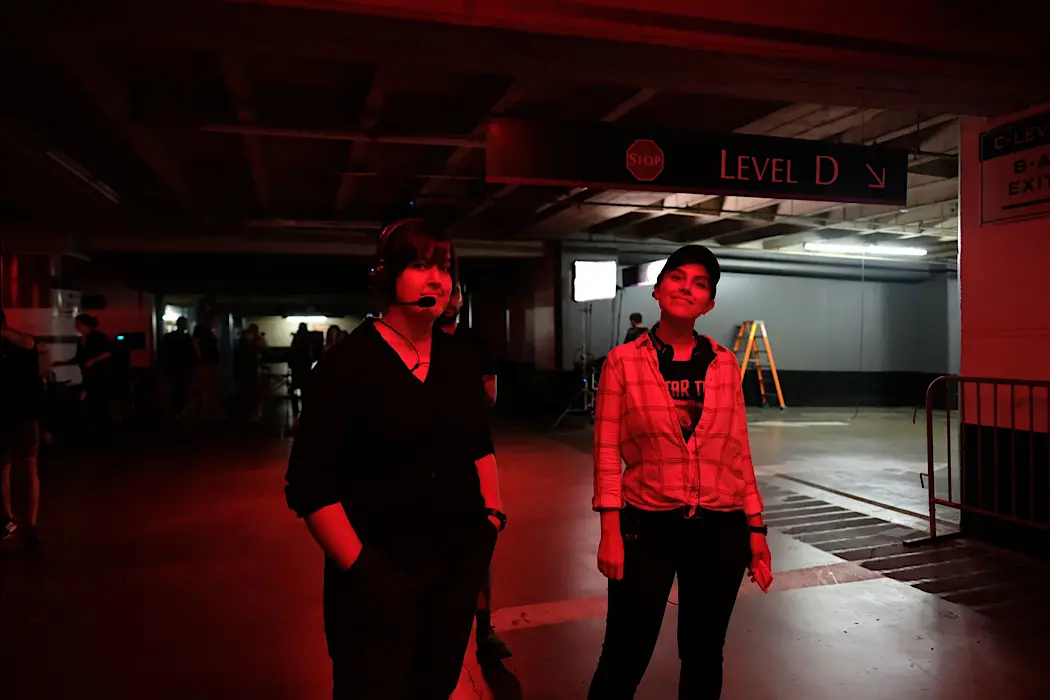
Kristy Strouse is the Owner/Editor in Chief of Film Inquiry,…
In Natasha Kermani‘s film Lucky, which just arrived on Shudder, May (played by the amazing Brea Grant), a self-help writer, suddenly finds herself fighting for her life every night by a masked intruder.
I was able to speak with the very talented cinematographer of this new horror-satire, Julia Swain, where she was able to really guide us through her craft, her process, and all of the very important details she contributed to this terrific film:
This interview had been edited for clarity.
This is Kristy Strouse for Film Inquiry: Thank you so much for taking the time to speak with me today. I loved the movie, and I think you did an amazing job. The movie itself really resonated with me.
Julia Swain: Thank you!
Just to start off, as a DP, I’d like to hear how you generally get involved with a particular project, and also – how you got into this one?
Julia Swain: Natasha and I had worked together before, we had done some commercials and a music video, and had been wanting to do something narrative together. She brought me in to meet Brea and producers to pitch my vision of what I would do on the film in terms of references and the look. We hit it off and then we got to work.
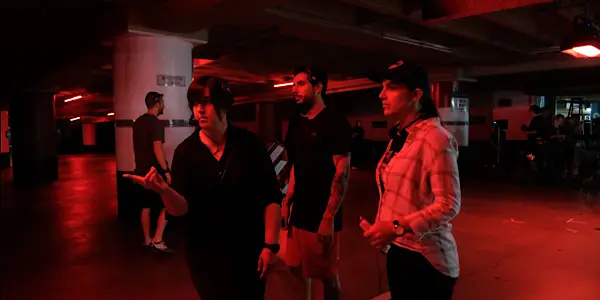
So, you got the script, then went back and pitched how you’d visualize it?
Julia Swain: She got me the script and a mood board. In my deck, I break down camera movement, lighting, anything having to do with the photography of the film.
That’s really interesting. I’m curious, do you look at their deck first or do you have your own process when you read the script and visualize it yourself?
Julia Swain: Sometimes I won’t look at the deck. I’ll just read the script first, which I always do. I make my deck and then open their deck and see if it aligns. Most of the time, it does. Other times I will look at everything just to get a general feel, to see if it’s something I’m interested in general. If I really love the script, I don’t even look at the deck, I try to go off and do my own thing and see how similar it is to what they want. It’s a bit more fun and challenging that way.
Sounds like it would be! So, what did you think of the script/story when you first read it?
Julia Swain: I loved the script. I read it a few times because it is one of those that has so much to say. And I say this a lot, but, I think a good script has a lot going on beyond what is written on its pages. I think as a cinematographer I’m looking to understand what that is, what is the subtext. As a DP, I really want to dig in and understand what that is. I remember the moment when I read Ted being like, “Yeah, that’s the man that comes and tries to kill us every night.” And I was like, what? This was crazy because her life starts off somewhat normal, so I was thrown off. I needed to figure out what was really happening.
That line! When that was said I think I actually said out loud “Wait, wtf?”
Julia Swain: I remember that moment. I usually like to shoot it in my head as I read, and it’s very interesting. I was very interested in diving into the satire elements and the slasher aspect, all of this coming together. I wanted to understand more deeply because this film doesn’t really fit in a box and I wanted to help see Natasha‘s vision through. I’ve read some that make you want to follow more of a formula in the cinematography, and this was not that.
All of those make perfect sense. I love the use of color, can you talk about that at all? What was your goal with the decisions you made?
Julia Swain: It wasn’t ever supposed to be super raw or gritty. We were trying to do something that was sophisticated and that really showed off what we’re capable of in terms of look to heighten the production value and to immerse you in the world a little more.
We don’t know where we’re going, we’re going on a ride. At first, we are doing something a little bit gentler in terms of cinematography, we’re slowly pushing in, we’re following her. Starting out in a slightly quieter camera world, as I like to say, where the camera is not really drawing attention to itself. It’s just observing and letting you kind of go along. Then, as this killer arrives and the body starts disappearing, we’re introducing whips to the blood, we’re introducing handheld a lot more, etc.
The camera kind of unravels along with her world. And then finally, the color pushes at the end. The world is like calming down a little bit, which unfortunately, I don’t think you really feel in the cut. But on camera, the bulbs faded from red, then back to white, and the world comes back to somewhat of a neutral look. There’s a slight camera filtration on the last act. If you look at highlights in the frame, they’re streaking a little bit and blooming in different ways than they were in the beginning. Because again the audience doesn’t necessarily know what’s real. The cinematography was working the entire time to keep you questioning things. And there are things in the photography that are also just not usual. So, pushing the boundaries in that way to just immerse us in this surreal feel was a fun thing to do.
I can imagine, I’m sure it was fun to work on!
Julia Swain: It was. And, you know, ultimately I think it’s mostly subtle. We looked at the different dynamics within every scene. Why is this scene handheld? Whose scene is this? Basically, the whole movie makes you ask questions. What is the relationship we’re looking at? And how does it change?
Absolutely.
Julia Swain: There are moments where Sara kind of zones out, so pausing the camera or doing something different with the light in those moments, just to add to this sort of surreal feeling. The final act is a bit bolder in terms of visually what it does. If you look at even the flowers behind them at the house, with Ted and her at the end, they’re super purple. I don’t know of any flowers that are really that purple but just pushing those limits all worked to question reality even more.
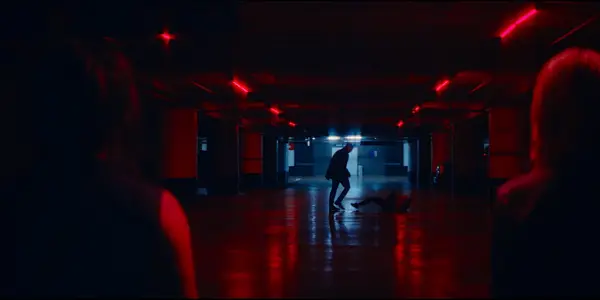
It does seem like it almost gets, more vivid as it goes on. And I also think that’s because the story just gets even more surreal and expands in scope. How important was the lighting?
Julia Swain: Lighting was definitely challenging because it was a smaller film. So trying to cover a large surface area with moonlight, etc. In the beginning, it’s all usually motivated from sources, and then as the story goes on, it gets a little crazier, like in the garage. The film doesn’t have a ton of locations, so how do we keep the photography interesting also.
Was that the biggest challenge?
Julia Swain: I think the biggest challenge was definitely shooting nighttime, because usually when you have that many night shoots, you have a balloon light or some big soft source, and we couldn’t afford that. We had to light from the ground. My team was so great. Brendan who is my amazing key grip… he actually built an arm that came off the roof. And we bounced light into a board to create a huge, soft source over everything. Some of these rigs they created were incredible, and I don’t know how they did it. They would help the look of the film but also save us time.
We tried to keep all the fights different in terms of the action of what happens in the fight and how she wins. But also, we’re in the same house for the majority of our shoot days. So how do you photograph the same space in interesting ways, and not make it the same every time? We didn’t have the resources to light the entire house or both sides of the house at once. So, today we are lighting the backyard, tonight, and tomorrow hitting the front yard. Staying smart about the schedule was key.
So, what was the collaboration with Natasha Kermani like?
Julia Swain: We both have very specific opinions in terms of photography. And I think as a cinematographer, you want a director who cares about where you put the camera, field of view. At the same time, she brought a lot of trust, because we just have a mutual respect for each other. We pushed each other creatively to really question everything that we did, we tried to do things with intent. It was a great back and forth. When we couldn’t do something, we left room for improvising, right on the day. We only had 15 days to make this movie. And I’m really impressed with how much we did in that time. So, it was teamwork from the two of us. And I think on this level, you really need to trust your director and DP to get it done.
That’s fantastic. And with Brea Grant, who is the star and writer, did you collaborate?
Julia Swain: I think between her and Natasha, they had a lot of discussion about the script and the motivation. We didn’t talk too much beyond cinematographer-actor relationship on set. She was wonderful in front of the camera. I think she was on board with my ideas when I came on, and she put trust in us and kind of let us do our thing.
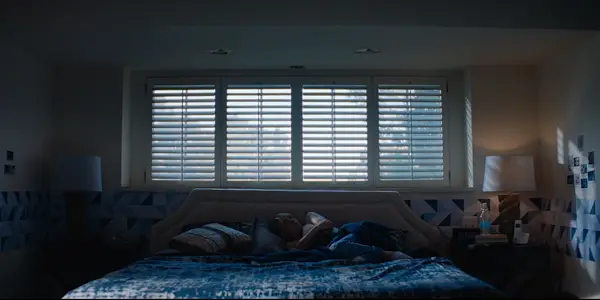
Are there any particular scenes that you love?
Julia Swain: I really loved it all. I had such an amazing experience shooting the whole movie. One scene that comes to mind is a daytime fight where she comes down the stairs and she stabs him in the neck and then blood falls on her face. We had a B camera for a couple days that a friend was generous enough to help us with and we got to shoot two cameras to try and get more options for the fights. We bring that fight into the house a little further where he is on top of her and tackles her. The entire sing-songy sequence with all the first responders. Also, any of the transitional things. Love those.
Those are really cool. I can really feel your passion!
Julia Swain: Yeah, those are all great! It’s interesting because we’ve talked about how this movie is surreal — you don’t really know what’s real in it. In the beginning, it’s got this time-loop element but it’s different for her each time that we see it rather than an exact repeat of events. Which is pretty fascinating.
Can you talk a bit about your visual ideas, and how you used them to propel the narrative even further? As a way to really bring this story to life?
Julia Swain: From the script there’s enough to understand and relate to that make you realize what the metaphor is. How a lot of women go through this, and that the character of May is not alone, even though she’s very alone in the film — it’s a universal experience for women. I think digging into the motivation and attention of characters and understanding where it’s going is important. And you don’t have to have all the answers, you can leave it up to the audience. When we are looking at these more metaphorical images, like in the garage, doing things that aren’t common in photography, for something that is more neutral, or modern-day. These decisions speak to whether or not this may or may not be real. That this may or may not be part of the natural world, or it could be in her head. Understanding these moments and enhancing them visually was really important to us.
Yeah, and as the story goes on it really starts to wear on her and the colors change, are more vivid.
Julia Swain: Yes! Natasha and I said the man’s color is red.. That was sort of an association with the idea that there is danger present, at least at the end. When it becomes this common thread.
So, would you say horror is your favorite genre to work within?
Julia Swain: I love horror and love shooting genre. Anything that’s not a modern-day LA is a fun challenge. I love to dig into characters and what these people are going through, I think the more there is, in that sense, the more I can get invested in. Genre work poses new challenges. And you get to decide what certain things look like, because it’s not necessarily based in reality, or maybe it is, but you can sort of play with what that means for the audience.
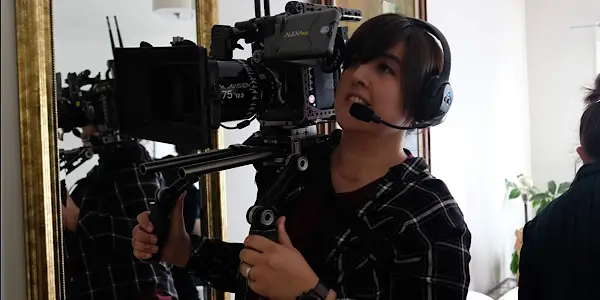
I love that. What’s next for you?
Julia Swain: I am prepping a horror short, with Alexandra Pechman. She’s also a horror fan. It is a home invasion thing and it takes you from night into day in the shot. I’m also attached to a few more things that I’m really excited about. I’m just seeing what lands.
Any advice for any young cinematographers?
Julia Swain: I think the biggest thing is: try to tap into who you are and the stories that you want to tell. I think that’s kind of the most important thing to focus on. I think when I started out, I tried to fit some sort of mold or latch on to what other people wanted to do and get excited about that. But I think as a cinematographer, you are putting yourself on screen, you are making so many decisions and you’re emotionally responding to the material. So I think tapping into who you are, and also – try and do stuff you really can get invested in. It’s easy to just go for bread and butter jobs to put food on the table. But I think if you can try and focus on and hone in on what you want to do, the kind of work you want to do, you can really shape your portfolio. I think that’ll help you get to where you want to go.
That great advice. Thank you!
Julia Swain: It’s the best job in the world.
You read it here readers – best job. That’s amazing. So, for the last question, what’s one of your favorite representations of cinematography in film?
Julia Swain: One of my favorite films is Blue Valentine. I watched that when I was starting undergrad and diving into production. Andrij Parekh mixed formats perfectly between past and present. It just made me think about how to capture two timelines in a relationship piece. That’s a film that really resonated with me. I thought I want to make movies like this. Ones that explore relationships.
[laughs] I hope there is, it’s a fantastic movie. And, I love that answer! Thank you again Julia for speaking to me, congrats!
Julia Swain: Thank you for talking to me!
Film Inquiry wants to thank Julia Swain for taking the time to speak with us.
Lucky is currently streaming on Shudder.
Does content like this matter to you?
Become a Member and support film journalism. Unlock access to all of Film Inquiry`s great articles. Join a community of like-minded readers who are passionate about cinema - get access to our private members Network, give back to independent filmmakers, and more.
Kristy Strouse is the Owner/Editor in Chief of Film Inquiry, writer, podcaster, and all around film and TV fanatic. She's also VP of Genomic Operations at Katch Data and is a member of The Online Association of Female Film Critics and The Hollywood Creative Alliance. She also has a horror website: Wonderfully Weird & Horrifying.













